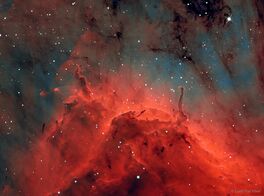Pelikan Nebel: Unterschied zwischen den Versionen
Gerard (Diskussion | Beiträge) KKeine Bearbeitungszusammenfassung |
Gerard (Diskussion | Beiträge) K (→References) |
||
| Zeile 4: | Zeile 4: | ||
The Pelican is much studied because it has a particularly active mix of [[star formation]] and evolving gas clouds. The light from young energetic stars is slowly transforming cold gas to hot and causing an [[ionization]] front gradually to advance outward. Particularly dense filaments of cold gas are seen to still remain, and among these are found two jets emitted from the [[Herbig–Haro object]] 555.<ref name="apod20111126"/> Millions of years from now this nebula might no longer be known as the Pelican, as the balance and placement of stars and gas will leave something that appears completely different. | The Pelican is much studied because it has a particularly active mix of [[star formation]] and evolving gas clouds. The light from young energetic stars is slowly transforming cold gas to hot and causing an [[ionization]] front gradually to advance outward. Particularly dense filaments of cold gas are seen to still remain, and among these are found two jets emitted from the [[Herbig–Haro object]] 555.<ref name="apod20111126"/> Millions of years from now this nebula might no longer be known as the Pelican, as the balance and placement of stars and gas will leave something that appears completely different. | ||
==External links== | ==External links== | ||
Version vom 12. August 2023, 13:11 Uhr
Der Pelikan Nebel (bekannt auch als IC 5070 and IC 5067 is an H II region associated with the North America Nebula in the constellation Cygnus. The gaseous contortions of this emission nebula bear a resemblance to a pelican, giving rise to its name.[1] The Pelican Nebula is located nearby first magnitude star Deneb, and is divided from its more prominent neighbour, the North America Nebula, by a foreground molecular cloud filled with dark dust.[2] Both are part of the larger H II region of Westerhout 40.[2]
The Pelican is much studied because it has a particularly active mix of star formation and evolving gas clouds. The light from young energetic stars is slowly transforming cold gas to hot and causing an ionization front gradually to advance outward. Particularly dense filaments of cold gas are seen to still remain, and among these are found two jets emitted from the Herbig–Haro object 555.[1] Millions of years from now this nebula might no longer be known as the Pelican, as the balance and placement of stars and gas will leave something that appears completely different.
External links
- Pelican Nebula Close-up
- North America and the Pelican
- Nebulae in the Northern Cross
- IC 5067 in the Pelican Nebula
- Northern Cygnus
- ↑ 1,0 1,1 Referenzfehler: Es ist ein ungültiger
<ref>-Tag vorhanden: Für die Referenz namensapod20111126wurde kein Text angegeben. - ↑ 2,0 2,1 Vorlage:Cite journal

